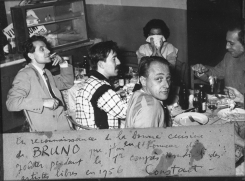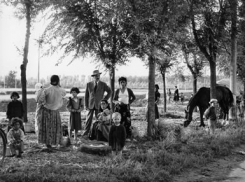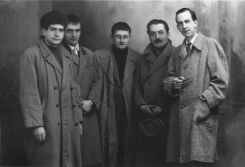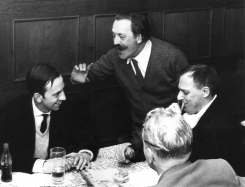Situationist International 1958-1960
In the summer of 1956 Asger Jorn invites Constant Nieuwenhuys to come to Alba, Piemonte (Italy), for the congress Industry and fine arts, an iniative of Mouvement pour un Bauhaus imaginiste (MIBI). At the congress Constant gives the lecture Demain la poésie logera la vie, in which he pleads for a liberated architecture that stimulates a creative way of life instead of impeding it. At the congress Constant meets the lettrist, Gil Wolman, who lectures on Unitary Urbanism (the synthesis of art and technology).
Invited by Pinot Gallizio, Constant and his family remain in Alba for a few months. During his stay in Alba Constant notices the inhumane circumstances in which the gypsies in Alba live. Inspired to improve their situation Constant creates, what later will be called his first New Babylon model, Design for a gypsy camp in Alba. In December 1956 Guy Debord visits Alba to meet with Constant.
This proves to be an inspirational encounter for both men. In 1952 Debord founded the International Lettrist; he is author, film maker and activist. Debord wants to create a more radical movement, which abandons the fine arts and fully focuses on psychogeography, in which the boundaries between art and life are totally dissolved. In 1957 Debord and Jorn bring together the International Lettrist and the Mouvement pour une Bauhaus imaginiste. They call it the Situationist International and refuse to regard their movement as an art movement.
Constant doesn’t join the SI right from the start. Constant aims for a synthesis of arts, a co-op with painters, sculptures, architects and construction technicians, to break with the monotony of urban development as well as the political powerbase in the fifties. This co-op is still not possible within the SI since architects and technicians haven’t joined the movement. However, when the group backs the principles of unitary urbanism that he and Debord defined in Déclaration d'Amsterdam in 1958 he eventually joins the SI. An intensive correspondence between Constant and Debord follows. Costant writes many theoretical articles for the French SI magazine.
After reading Homo Ludens by Johan Huizinga Constant develops the idea for a futuristic city. He develops this idea by drawing maps, writing texts, building constructions, and models. Debord summarises his project under the name Babylon and Constant adds the word New to it referencing New York, New Delhi and New Orleans. In 1959 the New Babylon project is exhibited in the Stedelijk Museum Amsterdam (SMA). The succes of the New Babylon exhibition inspires the SI to plan a large group exhibition for April/May 1960. This exhibition, however, will never take place; conflicts in the group lead to a split up and several suspensions. In 1960 Constant leaves the group for the same reasons he was weary about joining it in the first place. In 1961 Debord himself is the only original founding member left in the SI.
Early Period 1920-1947
CoBrA 1948-1951
Towards a Synthesis of Art 1952-1956
New Babylon 1956-1974
Situationist International 1958-1960
Late Period 1974-2005
Image

Image

Image

Image

